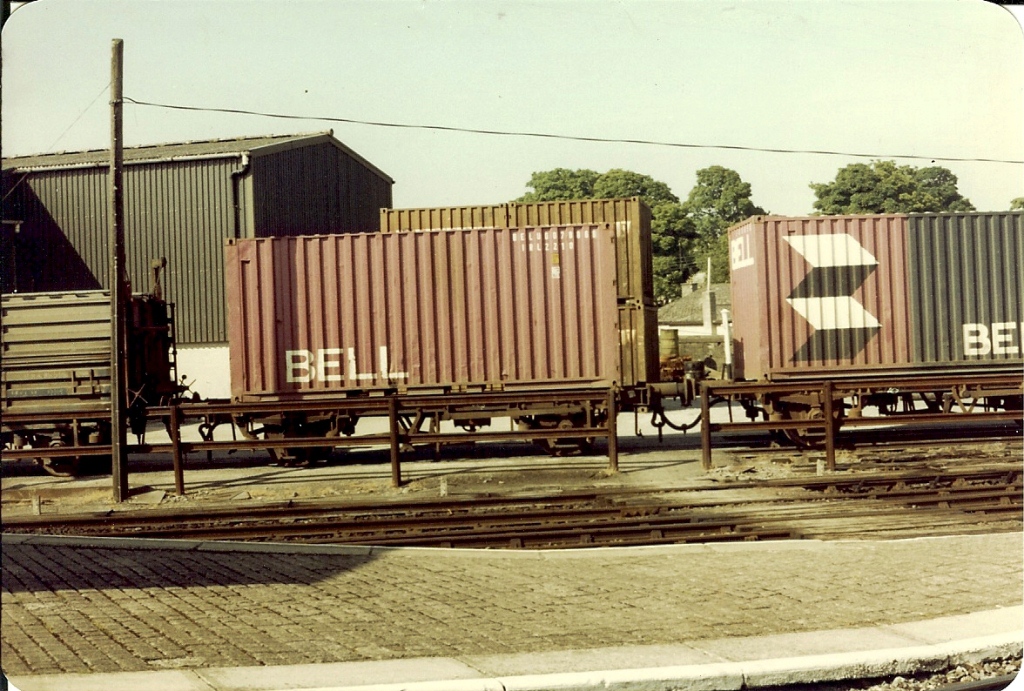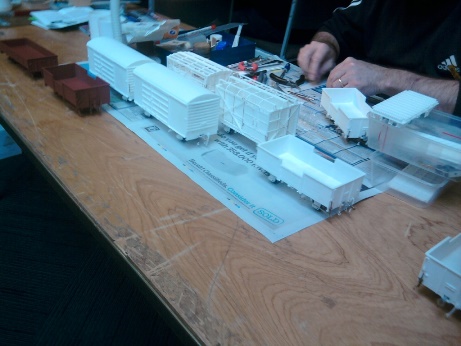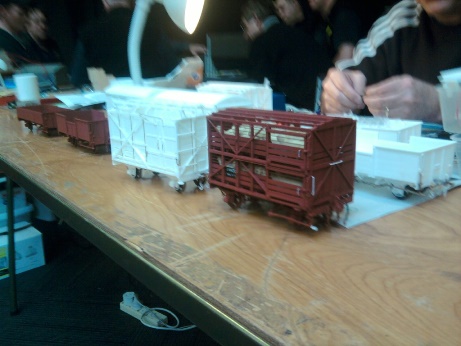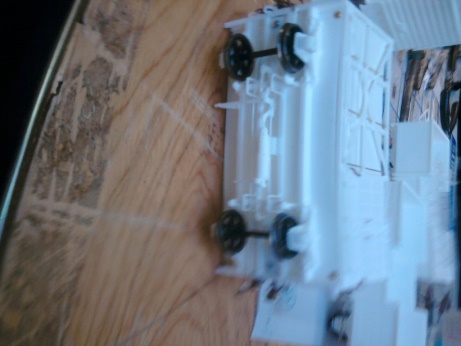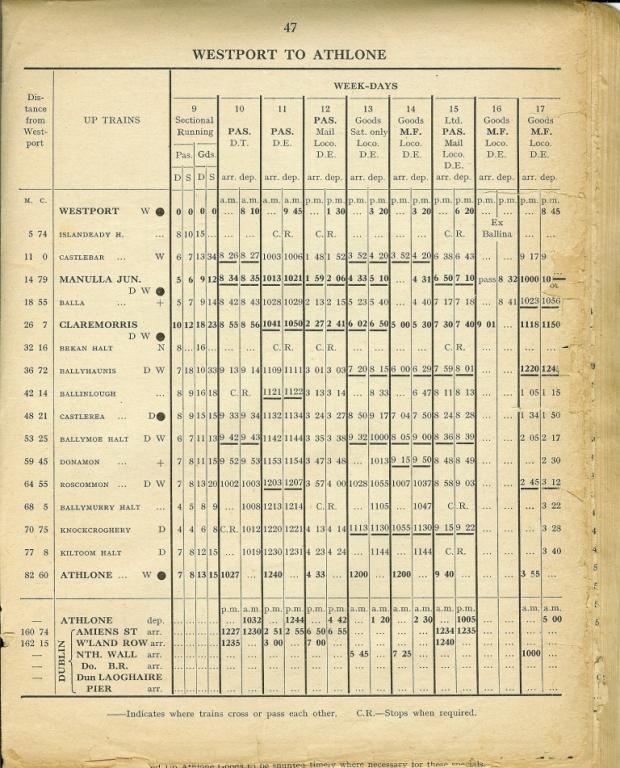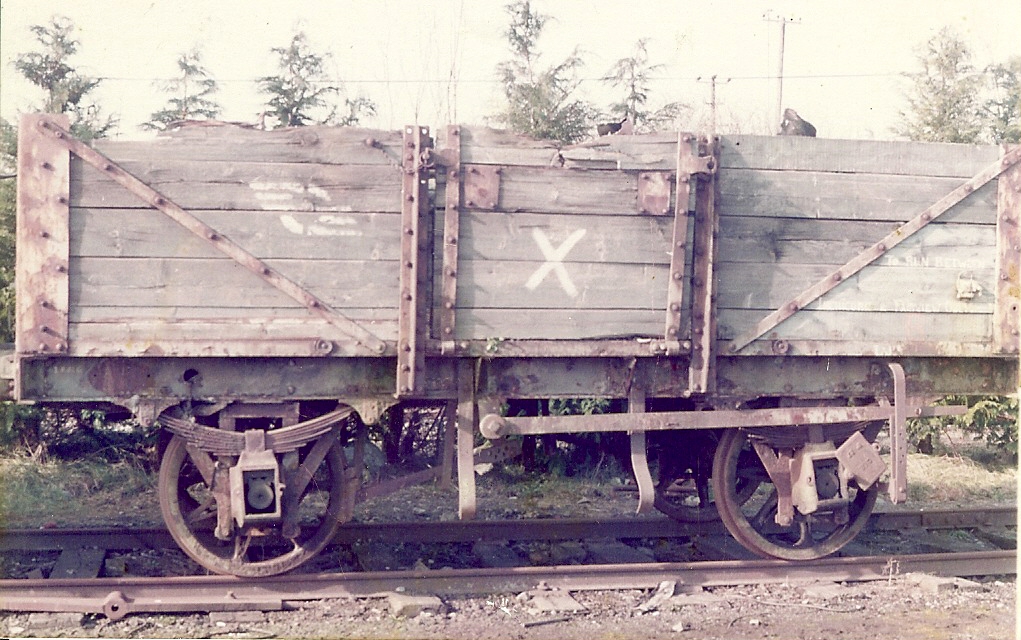-
Posts
4,862 -
Joined
-
Last visited
-
Days Won
119
Content Type
Profiles
Forums
Events
Gallery
Blogs
Store
Community Map
Everything posted by Mayner
-
Many of the earlier road switchers like the Alco RS2 & 3 models and EMD GP7 were set up to run long hood forward this was as much to do with crash protection as tradition. Funnily enough Kiwirail found that drivers would sometimes turn a double cabbed loco if a wye or turning triangle is available rather than change ends. This happened at one particular terminal where turn-round time was tight and did not give enough time on a cold winter night to adequately heat the second cab before departure. Basically after several hours on the road, drivers did not like leaving a nice warm cab, to cart their gear to the other end and face problems with de-misting the windscreen and warming up the cab on the return journey. The American export locos are very close in detail to their US cousins, in New Zealand most locos were basically scaled down American road switchers, the 645 engine locos are on the way out mainly because of age and poor fuel economy, the GE U Boats 40 years on still highly regarded for their fuel economy, smooth riding and low speed hauling ability.
-
The loco can be built in OO or 21mm assembling a rigid OO chassis is fairly simple and she should be fit to go round 2' radius curves. I will certainly look at doing a small batch in OO Gauge rtr.
-
Marcway also do a plastic sleepered OO Gauge chaired bullhead flexible track under the Scaleway label http://www.marcway.net/smp.php which is fully compatible with their OO gauge points. The flexible track looks better is probably easier to lay and definitely easier to ballast than Peco and is typical of main line track in the UK and Ireland up to the widespread use of concrete sleepers & CWR. The lighter rail section should not be an issue unless you use old Triang or Lima locos and stock, in which case its better to upgrade with better quality wheel sets that don't loose their plating and collect dirt. Code 100 track is probably on its way out, over 20 years ago Peco introduced its Code 75 flatbottom system more recently Peco and Atlas have gone head to head developing competing Code 82 track systems for the American market.
-
Most lasted to the late 50s with 6 surviving into the early 60s. They seem to have worked passenger and mail trains on the Sligo and Mayo lines, Dublin-Bray suburban trains (both routes) and Wexford Mail trains until replaced by diesel railcars/locomotives.
-
Great work the loco and her load in the heading photo certainly looks like its straight out of one of one of Neil Sprinks' books on the SLNCR. Vans of bagged cement, ale, cigarettes and Belfast linen for Sligo with a couple of empty cattle wagons at the tail end for Collooney. I don't think the difference in size between the Alphagraphix and scratch built wagons is too noticeable, the GNR vans were to a more recent design than the SLNCR vans and may have been slightly larger. if you are looking at the 1950s period its worth considering the Parkside BR Plysided Van which is very close to the last batch of GNR bagged cement wagons and a good basis for the standard CIE H van. Besides traffic from the GNR to Sligo the SLNCR seems to have conveyed traffic from CIE into Northern Ireland and possibly Donegal, one of the photos in SLNCR an Irish Railway Album is a well loaded afternoon Enniskillen-Sligo goods including a solid cut of 6 CIE H vans towards the rear of the train.
-
Some photos of the build of the study models for the ex-MGWR 2-4-0, this is basically to see if the model is buildable. The basic assembly of the platework is complete, the boiler fittings are just plonked on for general effect, some modifications are needed before the kit is released. The model is assembled in OO with Romford wheels resulting in the wheels being inside the boiler/firebox shell. There was a mix up at the engravers the locos ended up in nickel silver, the tenders brass. 650 Class late MGWR early GSR condition, superheater round top boiler, round canopy cab, tender coal rails. These cabs were used as a replacement for the "Flyaway" cabs on the 2-4-0s and some 0-6-0 but were phased out during the 1930s, they were low (a source of staff head injuries) and gave poor protection from the weather. 650 Class late GSR condition superheated round top boiler, Inchacore cab with round spectacle plates. The GSR replaced the canopy and remaining "Flyaway" cabs with what was basically a standard Inchacore pattern and replaced the cast iron chimneys with a standard Inchacore "built up" variety. Close up of the loco showing cab and smokebox riveting. At this stage its difficult to predict the probable cost or release date, but I would expect Summer/Autumn 2014.
-
The layout slipped back into a bit of a hiatus, I am not sure if it was the winter blues or I hadn't figured out how to deal with the near side of the road. Between the combination of eye level viewing and scenery in the foreground its easy to block out the view of the trains and road vehicles on the tramway. The field boundary will be marked by a combination of low hedgerows and wire fencing, 3T on the Arigna Tramway or Tralee and Dingle That combination of narrow country roads, wild hedges, distinctive farm gates and regional variation in landscape between different parts of the UK and Ireland is difficult for a modeller to capture and can make a layout or a model really stand out. Mid-Wales, the Home Counties and the Yorkshire Dales are distinctly different in terms of their landscape, railways, architecture so why not take the same approach to an Irish layout.
-
I think a few flats with Bell or British Rail Freightliner containers & Guinness kegs would not look out of place in the consist of your loose coupled Cork-Waterford goods. Improving train payload and better stability at speed may have been one of the main factors in phasing out the 4w flats which were eventually down graded from 50 to 35mph max. The bagged cement and beet doubles seem to have been converted form flats originally used in fertiliser and keg traffic. 4w flats still appeared in container traffic into the 90s mostly coal, oil and grain and mixed consists with keg, cement, oil, tar and container traffic over the Mayo & Sligo roads were not unknown.
-
Not quite desktop 3D printing but a good indication of the probable direction of the hobby. Finished and work in progress. A local designer is using a bureau to produce wagons, the bodies and roof are basically printed in one piece with a separate floor and chassis, the only metal parts are wheels bearings, couplings and brake levers. Finished sheep wagon complete with sheep! The models are printed in a nylon material which is very strong and flexible (Shapeways WSF) the slightly pitted surface finish of this material does not seem to have been too much of an issue in the slightly larger scale. Fully detailed underframe featuring airbrake triple valve, piping and linkages. Costwise its a bit scary around $4-500 for the parts to produce the sheep wagon(incl sheep), but would result in a major saving in time over scratchbuiding or a conventional kitbuilding once the 3D modelling was complete.
-
The plot thickens I have a LGRP 1930s photo of a similar wagon 10567 with the number plate in the same position as the Mullingar wagon. It could be one of a batch of wagons ordered by from Metropolitan in 1920, the GSWR supplied of these 20 wagons at cost price to the CBSCR. The Mullingar wagon may have been used for transporting railcar parts between Fairview and Inchacore, the wagon in the LGRP has an interesting load a pair of steam locomotive wheelsets.
-
The length of container is governed by the load. 30 & 40' containers are used mainly for light bulky items manufactured goods and imports, 20' for heavy dense cargo, commodities such as meat, dairy goods, and bulk cargo liquid of solid. A lot of the traffic was Irish food exports in 20' containers to the European market, including pasta to Italy. It might be worth looking out for used Hornby or Triang-Hornby freightliner container wagons on E-bay, the wagons would need shortening and possibly lowering but the bogies/trucks are right for the 1st batch of bogie container flats, the containers typical of the transition era.
-
Bells original operation was based on Waterford Port possibly in the late 60s originally planned to use road transport and went over to rail as it was a better option given the state of the roads and relatively long haul from Dublin, Cork and Limerick to the port. This was probably based on the success of the B&I Cork-North Wall Liner which replaced the B&Is Cork-Swansea cargo sailings. Originally only 20'x8' boxes would have been used on 20' flats, the 1st batch of the 42'9" flats were built in 71 and didn't really become common until the late 70s. The original containers were 8, CIE started clearing routes and introducing wagons suitable for 8'6" containers with the 1st batch of bogie and last batch of 4w flats in the early 70s. Usually there were two daily services to and from Dublin and one each from Cork and Waterford, later Belfast & Sligo. Bell containers were also carried on CIE scheduled goods and liner trains. Containers were also moved as single wagon loads sometimes marshalled next to the brake van on loose coupled goods, in the final years most Limerick Sligo goods trains seem to have carried Bell Containers. The traffic grew very heavy in the 80s and 90s with lot of extra trains on weekends moving export traffic from factories to Waterford Port.
-
Excellent work on the locos and stock I especially like the staff snatcher on the U2 and scratchbuilt Brown Van.
-
I think its best not to get too hung up on trying to match the exact colours, as shades may vary in different light and atmospheric conditions, colours weather over time locos and rolling stock covered in corrosive fall out from the locomotive steam or diesel, brake dust and muck thrown up from the track. One of the best examples of weathering was the Sulzer locomotives in the Supertrain livery on the Inchacore sound barrier in the 70s & 80s, the tan gradually weathered to pink due to the effects of sun and rust, while locos such as B111 and the twins B113&4 remained well black . Friends in the UK decided to paint a full sized brake van in BR bauxite and were surprised when it first turned out to be a salmon pink and took a year or so exposure to weather to the familiar dark brown. I have several coaches not quite running around in what's supposed to late 50s light green with a single line. I used a Humbrol possibly Southern Multi Stock for the first coach then had aerosols matched by the local paint supplier for more recent stock. I have a single coach in the CIE dark green based on a Tayima Enamel and a few relics running around in what's supposed to GSR/LMS Maroon using a car enamel, maroon has considerably darkened almost to the earlier purple lake over the past 20 years . I suppose the lesson is that if you wait long enough it will eventually come right
-
The curtain siders really look the part, the Dapol chassis is probably the nearest thing to the CIE standard 20' underframe of the 1960s Rtr OO gauge H & sliding door vans are already available from James Mackey misr@eircom.net, he does not have an on-line presence, there was a favourable review of his H van and corrugated opens in the May 2013 New Irish Lines.
-

Bargain Bachmann 4F from Marks Models
Mayner replied to Warbonnet's topic in British Outline Modelling
The Bachmann 3F is also worth looking at very close to the NCC 0-6-0s and a good basis for the more modern GSWR & DSER types & 461. http://www.ehattons.com/52551/Bachmann_Branchline_31_627A_Class_3F_0_6_0_3709_in_LMS_black/StockDetail.aspx The main draw back with a rtr conversion is that apart from the Northern Companies and DSER few locos had a straight running plate like the 3 or 4F, most Southern locos either had squiggly or raised running plates which are difficult to model and a major part of the character of the Irish locos. -
A good example of a weathered wagon, I caught this gem in Mullingar about 30 years ago. These were basically the standard Irish open wagon for about 40 years from about 1915 up to the introduction of the Bulleid opens in the mid 1950s.
-
Desmond Coakham's articles in Railway Bylines Summer Specials (Irwell Press) are well worth looking out for. Excellent articles with brilliant photos on Grand Canal St (Number 5) Branch Lines (Number 3) & The Harcourt St Line (Annual No 3) and cutting comment on the Celtic Tiger Economy that turned out all too true.
-
Waterford 1.-Mallow/Killarney 2.-Kilkenney/Dublin via Carlow or Portlaoise 3.-Limerick Junction/Limerick 4.-Macmine Junction/Wexford/Dublin. 5.-Rosslare/Wexford.
-
Nelson Brilliant looking layout and the very best of look with the 70 Class.
-
There were a hell of a lot of schemes convert/extend the C&L with little physical substance apart from an underbridge at Keady and the Government funded line to the mines. All the same the C&L was probably the most profitable part of the GSR at least up to 1934 paying a 5% return on its capital and probably making a small profit on its operations. All because the Ratepayers signed up to an early form of Public-Private Partnership in the 1880s and agreed to guarantee a 5% return on the capital in pertuity. This along with the National question probably lead to a lot of the hostility that blocked any extension of the line and the friction that boiled up between staff and management during the War of Independence. The Dublin & Blessington and Clogher Valley were in a similar position with the ratepayers having to provide a guaranteed return on capital to a pair of railways that were basially broke. The Free State & Stormont basically had to buy out the shareholders to take the strain off the ratepayers and cover pension costs when the lines were abandoned.
-
The February 1973 Irish Railfans News includes original CIE publicity posters "Travel the Tomorrow way Today" of the original Supertrain on the Wexford Line in the Vale of Avoca and on the section below Vico Road Killiney. 001 looks especially smart with a possibly unique version of the Supertrain livery with the centre section of the roof painted black. The original concept behind the Supertrain was to run a relatively frequent service of short trains similar to the Midland Railway in the early 1900s. This policy came unstuck when service frequency was cut back following the oil crisis in the early 70s and something more powerful was required than the existing power to keep time with the increasingly heavier less frequent. Up to the widespread introduction of the MK3s the heaviest main-line trains tended to be made up of conventional rather than Supertrain stock. Most of the morning trains out of Dublin to the provinces and the up evening working tended to be made up of conventional stock, with Supertrains used on the more lightly loaded but prestigious morning Up trains and Down evening workings the successors of the expresses of the 1960s. Lines like Westport, Sligo & Rosslare were almost exclusively conventional stock until enough MK3ss were available to cascade the MK2D to these secondary main lines The 071 were definitely introduced in a darker shade of brown to that used by CIE, and the locos seem to become increasingly grimy in service possibly because their excellent reliability allowed really intensive use and less time on shed than the 001s which were never as reliable at the thoroughbred GMs
-
Stephen Funnily enough I have a copy of the 1960WTT which adds even more to the confusion: I will post it up when I get a chance. Main Line 4 Passenger up and down, (2 Limited and Night Mails, 1 stopping Passenger, 1 Cu na Mara Railcar express passenger) Branch 4 Passenger+ 1 Mixed up and down. C Class possibly 6 wheelers or GSWR or Midland Bogie & 6w van) The Night Mails would mainly carry mails and urgent freight traffic, possibly a single coach, heating, mail and luggage vans and a tail of vans and cattle wagons. A lot of pre-amalgamation ventilated vans would have remained in service for perishable traffic into the 60s possibly traffic to the Dublin Fish Market from Westport or Ballina. Goods "Ballina Goods" fast overnight limited stop goods 9am arrival Westport, mixed train connection to Ballina! "Westport Goods" all station pick up goods Athlone-Westport late afternoon arrival Westport. A Class on the main line apart from the Cu na Mara, with a pair of C Class on the Ballina Branch. In steam days large ex MGWR Cs Class 4-4-0 on main line passenger, possibly Ks or 650 Class 2-4-0 on the Mails, 650 or Achill Bogies on the branch. The Ballina Goods actually ran to Ballina ex MGWR Standard Goods L or Lm Class similar in size to J15 due to weight restrictions on Moy Viaduct. Ex-MGWR F "Cattle Engines" on Westport Goods, ex-MGWR As Cs Class 4-4-0s and F Class on main line cattle specials. N J Mc Adams mid 70s 2 article IRRS paper on the Mayo Line provides a good background of history and operations up to around 1975.
-
I still keep thinking Davids model looks more like Drumkeeran than Arigna, then again my layout does not look anything like Keadue The whole history of coal mining and iron making in the area is quite interesting with one of Irelands earliest railways an 18th Century Plateway linking the mines and Ironworks, the Lough Allen Canal and the Government 1918 built Arigna Valley Railway from Arigna Station to Derreenavoggy (Arigna Fuels) and Aughabehy. http://www.arignafuels.ie/about/history/ Coal traffic on the narrow gauge only seems to have come into its own in the 1930s when the GSR drafted in 4 extra locos and a large number of wagons from the Cork Blackrock & Passage Line. There probably never was enough traffic to support a broad gauge line or there may have been some un-written agreement between the Midland and GNR not to build into the area, Irish companies keeping to their own areas, with the Sligo line skirting the border between Leitrim and Roscommon and the Midland's Killeshandra and GNR Belturbet branches probing the frontier and that 20 odd mile gap between Sligo and Bundoran.
.png.c363cdf5c3fb7955cd92a55eb6dbbae0.png)


